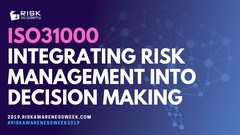Наши популярные онлайн курсы
At Risk Awareness Week 2020, Julian Talbot, risk author and consultant, shared his top insights from over twenty years in risk management.
- Anxiety is your friend
Talbot says: “A little anxiety is a good thing, it wouldn’t exist if there wasn’t some evolutionary edge from it.”
Lesson for risk managers: “You can’t wish away anxiety the key to addressing it is to use it as a tool. Put in place some sort of contingency, define this uncertainty and make it your friend.”
- Plans may be worthless, but a plan B is priceless
Talbot says: “You always want to have a Plan B in place before you execute Plan A. The pilot in a military aircraft wouldn’t go into the air without knowing they have an ejector seat and it’s been tested, because it’s too late when things go wrong.’”
“Have a Plan B which is ready to go, you’ll win brownie points but more importantly you will have managed that risk effectively.”
- Intuition as a four-step process
The four steps of intuition according to Talbot are:
- Learn how to listen
- Recognise the intuition from the background chatter
- Trust that it is right
- Take action accordingly.
“Leave any one of those steps out and you may as well not have bothered. For any good risk manager to make good decisions and good allocation of resources we need these four steps.”
- The Road to Hell
Talbot says: “We judge ourselves by our intentions, but we judge other people by their behaviour. The corollary of that is that other people don’t judge us by what we intended, they judge us by what we actually did.”
Lesson for risk managers: “If risk management is important to you and your organisation then don’t just talk about it… What you do carries a lot more weight but the most important thing is to spend your time managing risk.
“If you want a simple hack to make risk important just make it the first agenda item for every meeting at your organisation. You might want to talk about health and safety or financial risk or there might even be nothing to talk about but at least it’s there on the agenda as something which gets first prominence at every meeting.”
- Culture = performance
“Ultimately culture change drives risk… so if you have some objectives in the organisation… which are fairly well identified then you start with the end in mind and do a training needs analysis .
“If you spend time on training that says it’s important and… people come back with new skills. They have a bigger toolbox to solve problems in the workplace whether that’s negotiating contracts, leading their people or whether it’s operating a forklift. And tools change behaviour.”
- DRD4 has a lot to answer for
“We know human beings take risks and there’s a lot of research that suggests that dopamine receptor D4 has a role to play in this. The research is inconclusive so you can take it with grain of salt but there is a lot of support this idea.
“This is what happens with the old rogue trader problem where we have a great risk management framework, but somebody’s still dumping all these options positions and futures positions into the market without really good control over them and before you know it your organisation is facing bankruptcy or a major loss.
Lessons for risk managers: “When you learn something new, dopamine is released in the brain. We feel good, we a get a bit of a rush, so if you invest in training not only are you getting the benefit of spending time with people and investing them – you’re also giving them the dopamine which they would otherwise get by hanging off scaffolding without a harness or by putting too many options positions unhedged into the market.
- Dinosaurs still rule the world
Talbot says: “We often wonder why people make silly decisions well it’s because the dinosaurs, the reptiles are still running the world.
“I subscribe to the Triune brain model. Ultimately and here’s the problem – the reptilian brain sits on top of spinal cord, so whatever you’re thinking about from a logical point of view or an emotional point of view, the reptilian brain is actually exerting more immediate control over your actions.”
Lesson for risk managers: “When you are trying to communicate with people, you need to think about the emotional content and the fear content.”
- Who makes your decisions?
The problem: “We want to believe we have free will and we like to believe that we consciously make decisions, but most of the research says that we don’t. A lot of neuroscience shows that decisions are happening in the brain before we’re consciously aware of them.”
Lesson for risk managers: “I think we can modify the subconscious through training and through repetition. Partly also, the practical research means that the environment around us often influences us more than more than we credit and perhaps even more than we influence it.
“To be a more effective risk manager and to get the resources you need for any enterprise risk project you need to get the connection with people to get them thinking about risks.”
- Cyber cyber cyber
Talbot says: “The biggest risks that we’re facing right now and in the 21st century is cyber cyber cyber.
“There are 42 undecillion [?] things, which basically means every electronic thing built for the next 10,000 years can be connected to this giant network and when you start thinking about risk you can’t do that in isolation anymore.”
Lessons for risk managers
“Cities will be full of driverless cars, traffic lights, process control, factories, construction, the stock market – every single thing is connected and they are affecting each other. So, for risk managers, now’s the time to find out about cyber and to get your head across this.”
- The inevitable
Talbot says: “Where we are going is inevitable. We are going towards a connected world, we’re going towards genetics, nano technology, robotics, the internet of things and every single thing is becoming connected.
Lessons for risk managers: “Humanity will look back on Covid-19 in couple of hundred years as being a significant point in history, but in thousands of years’ time humans will be looking back on the start of the third millennia as an era when humanity first started to connect.
“Right now, when you think about risk you’ve got to think about [the fact that] we are in an epoch, we are at the start of the third Millennium approaching the most significant era in time.”
- Nothing is as important as you think it is when you are thinking about it
The theory: “When we think about something it rises in prominence. For instance, when we are thinking about cooking a meal… we need to pay attention. But we’re programmed as a result of this to think that what is happening now is more important.
Lessons for risk managers: “What we get out there in the media and what ideas we share with our colleagues, our clients and our workers in terms of risks, risk strategies or risk analysis – these are the things that people will deem important because it gets their attention.”
Check out other decision making books
RISK-ACADEMY offers online courses

+ Buy now
Informed Risk Taking
Learn 15 practical steps on integrating risk management into decision making, business processes, organizational culture and other activities!
19,999,99

+ Buy now
ISO31000 Integrating Risk Management
Alex Sidorenko, known for his risk management blog http://www.riskacademy.blog, has created a 25-step program to integrate risk management into decision making, core business processes and the overall culture of the organization.
199,999,99

+ Buy now
Управление рисками
В этом коротком и очень увлекательном курсе, Алексей Сидоренко расскажет о причинах внедрения риск менеджмента, об особенностях принятия управленческих решений в ситуации неопределенности и изменениях в новом стандарте ИСО 31000:2018.
19,999,99




























